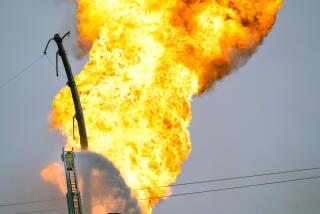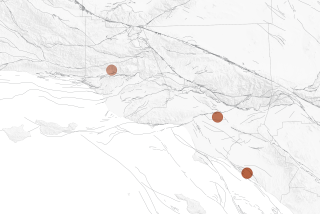Old Harbor Area Pipelines Prompt L.A. to Anticipate Buried Trouble
- Share via
The maps in Al Provost’s office tell the story of an underground world.
They show a subterranean network that most people never think about--an intricate maze of pipelines that run under city streets, carrying millions of gallons of water, sewage, natural gas, crude oil and other potentially volatile products.
Provost, a city engineer in the Los Angeles Harbor area, is responsible for knowing where these pipelines lead. But his maps, as extensive as they are, don’t tell all. Every once in a while, a surprise pops up--a mystery pipeline that seems to belong to nobody.
During a recent street widening project in Wilmington, for example, a construction crew discovered a pipeline that appeared to contain pressurized crude oil. The line was not recorded on any city map. No oil company claimed ownership of it.
Finally, baffled city officials turned to the Exxon Corp., which operates all the oil wells in the Wilmington area. Exxon tapped the abandoned line--which actually contained only traces of crude oil and methane gas--and then removed it as a favor to the city.
“We were very lucky,” Provost said, adding that it took city officials several weeks to resolve the problem, during which time no work could proceed on the project.
That incident prompted Los Angeles Councilwoman Joan Milke Flores, who represents the harbor area, to call for a review of problems that might be caused by unidentified pipelines throughout the city, and especially in the heavily industrialized Wilmington community.
“The driving force behind this is that there’s an infrastructure under the city that has not been identified,” said Flores spokeswoman Karen Constine. “It’s kind of like accidents waiting to happen.”
The Wilmington discovery was by no means the first time an uncharted pipeline has surfaced during a construction project, either in the harbor area or elsewhere in the city. According to Gene McPherson of the city Bureau of Engineering in downtown Los Angeles, uncharted pipelines are discovered five or six times a year in his district, which stretches from Fairfax Avenue to the city’s eastern border and north from 110th Street to Mulholland Drive.
In about 25% of those cases, McPherson said, the lines are in use. Sometimes, he said, it can take as long as three weeks for the city to figure out what to do with them.
“You have to assume the worst every time you find one of these things,” he said.
In interviews, McPherson and other city officials have said that they are relatively certain that they have complete records of water, sewage and natural gas lines, as well as underground telephone conduits and cable company lines. They are less certain about oil pipelines, in part because some were laid before the city began keeping records in the early 1930s.
Flores’ motion, which is scheduled for a hearing Jan. 17 before the City Council’s Public Works Committee, focuses mostly on the private pipelines that run under the city’s streets, carrying crude oil and oil products, such as gasoline.
The motion cites a disastrous accident on Venice Boulevard in 1976, in which an excavation machine struck an underground gas pipeline, starting a fire that killed nine people and injured 14. In that case, the National Transportation Safety Board ruled that Standard Oil of California had failed to supply the road-building contractor with the precise depth of the gasoline line, which was charted on government maps.
Oil industry sources say such an accident involving an unidentified pipeline is highly unlikely. They say most uncharted pipes are old lines that are no longer in use and do not pose such a threat. They say they know of no instances where a serious accident has occurred because someone struck an active pipeline that was not identified on government maps.
“Any kind of danger of breaking into them would be a minimal danger,” said Exxon spokesman Brian Dunphy. “It’s not like you have (unidentified) pressurized lines down there that are under the street.”
Jerry Engelhardt, who is active in the Western States Petroleum Assn., an industry trade group, said most industry officials are more concerned with preventing construction accidents, such as the Venice Boulevard fire, than with finding uncharted pipelines.
“People are aware that it happens, that once in a while you’ll find something, but I don’t think that it’s considered a big problem,” added Engelhardt, who is also vice president of Santa Fe Pacific Pipelines Inc., a company that transports gasoline, jet fuel and diesel fuel throughout six Western states.
Nonetheless, city officials say, by their very nature, unidentified lines pose a potential danger.
“We don’t know what might be underground and what might be under pressure,” said Provost. “I have to believe that (an accident involving such a line) might be as remote as an 8.5 earthquake. But it could happen. Anything could happen.”
Said McPherson: “It’s like the loaded gun. It’s not dangerous until something happens. Then it can be deadly.”
According to Dave Leatherman, an engineer with the city’s Department of Transportation, Los Angeles has a total of 524 miles of private fuel lines running under its streets. Those lines carry crude oil, gasoline and other products used in the refining process, such as naphtha, a highly volatile solvent.
The city has been keeping pipeline maps since the early 1930s and has an extensive permit procedure that dates as far back as 1927. Pipeline companies that use city streets are required to obtain a franchise from the city Department of Transportation and must file their plans with the Bureau of Engineering. Companies also must notify the bureau when they abandon a line, and the abandonments are also recorded on city maps.
But in some areas, particularly older areas such as Wilmington, oil lines were laid before the city laws took effect. Wilmington has had an active oil field since the turn of the century, and city officials believe there are many uncharted lines that were laid decades ago by private oil well owners.
In addition, Provost, Leatherman and McPherson said that during World War II, the military--which maintained a strong presence in the harbor area, especially in San Pedro--laid oil pipelines without notifying the city. Leatherman said his staff has asked the Navy several times to provide records of the pipelines, but “they have been reluctant to do that, possibly because of security reasons.”
But a Navy spokesman said Tuesday that the Navy knows of no pipelines in the harbor area whose locations are a secret to the city. Lt. Cmdr. Steve Chesser said that, aside from the lines that are active and on city maps, the Navy has just five inactive fuel lines, which run to its now-defunct fuel wharf at the Port of Los Angeles.
Chesser said those lines were abandoned in February when the fuel wharf was shut down. The Navy is now in the process of turning them over to the port, he said.
If Flores’ motion is adopted, these and other issues would be explored further. The motion calls upon the city fire and transportation departments, as well as the Bureau of Engineering, to look into “the various problems associated with unidentified pipelines” and to report back to the Council’s Public Works Committee within 90 days.
Leatherman and others have said the review would probably consist of further checking with agencies such as the Navy, as well as pipeline and oil companies, for records that might reveal uncharted pipelines. In addition, he said he would like to see city staffers draft guidelines for handling unidentified pipelines when they are discovered.
The motion does not direct the departments to identify the city’s uncharted lines--a task city officials say would be nearly impossible.
“You would almost have to dig a ditch across every intersection on all four legs of the intersection and try to get a cross section of all the pipelines that are there,” said Leatherman. “It’s a huge, monumental thing to take on, and whether or not it’s a productive, cost-effective, viable thing to do is quite another story.”
Added Provost: “I can’t tell you too much about what we might find. If we don’t have it (on city maps) and nobody else has got it, well then obviously it’s going to remain until somebody runs into it.”
More to Read
Sign up for Essential California
The most important California stories and recommendations in your inbox every morning.
You may occasionally receive promotional content from the Los Angeles Times.









